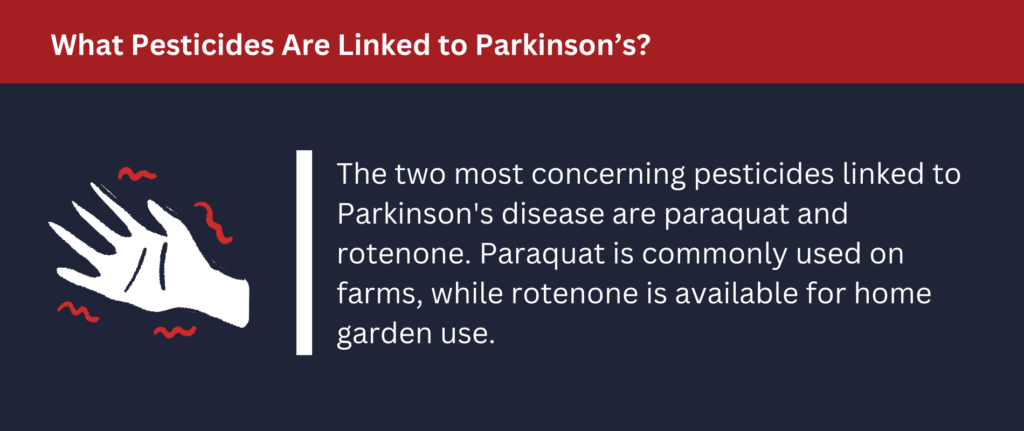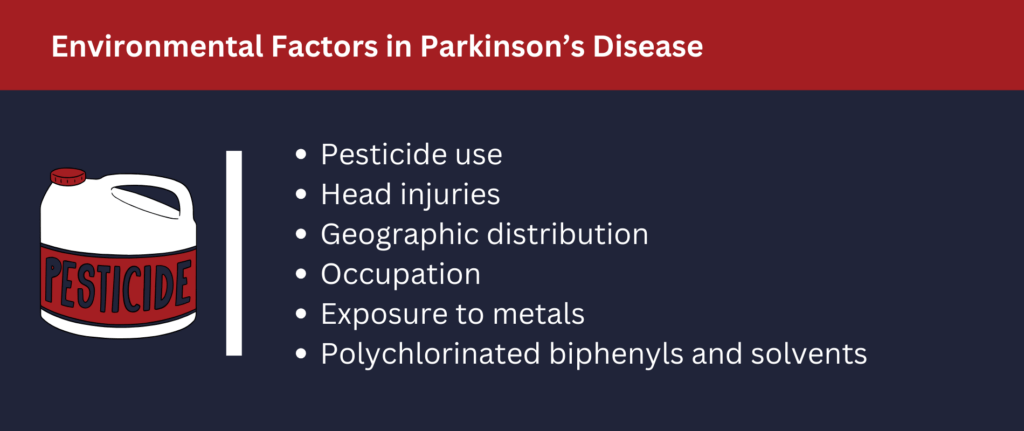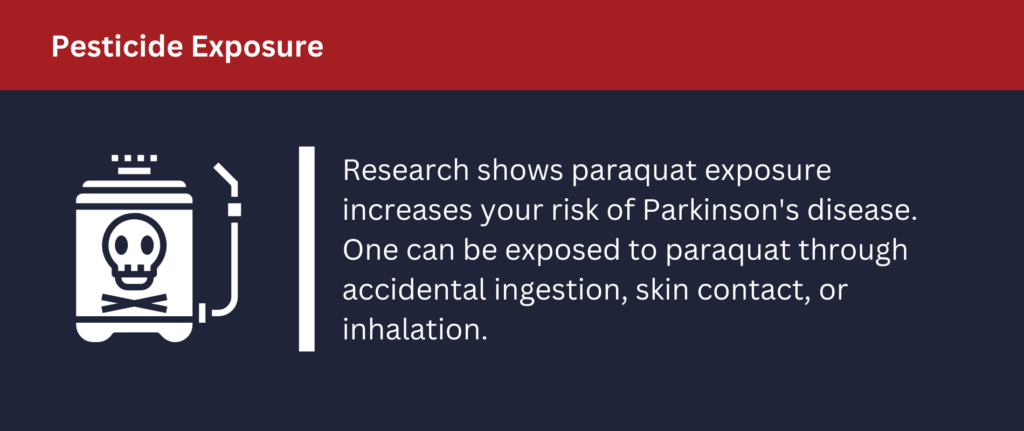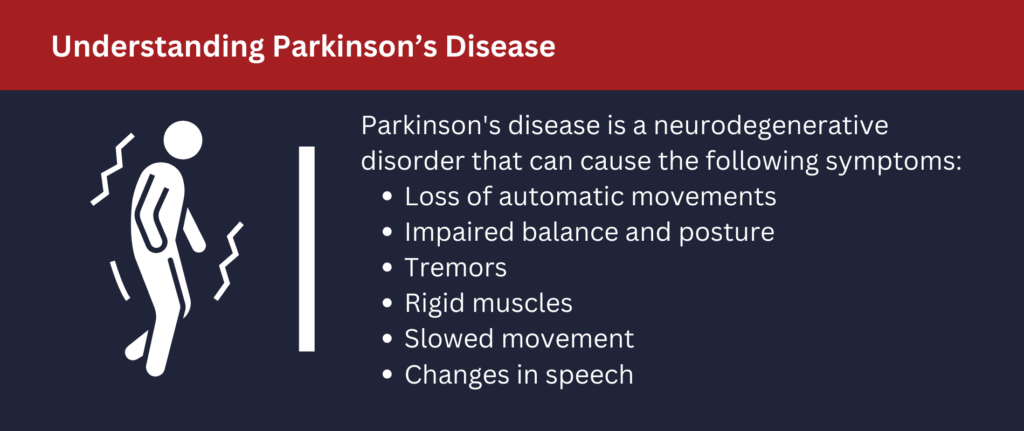
The pesticide most linked to an increased risk of Parkinson’s disease is paraquat. Several studies have shown that a person’s genetic makeup can make them more vulnerable to the effects of toxic substances, including paraquat. The chemical’s mechanism for action is the production of intracellular molecules, a reactive oxygen species that cause cell damage and oxidative stress.
Both oxidative stress and mitochondrial dysfunction are common themes in the general understanding of what leads to cell death in people with Parkinson’s.
PD is a progressive neurodegenerative disorder that has no cure. While the etiology of Parkinson’s disease is still largely unknown, the disease is likely to be multifactorial with environmental and genetic factors contributing to its development.
What Pesticides are Linked to Parkinson’s?

The two most concerning pesticides with an association with PD are paraquat and rotenone.
As mentioned above, paraquat produces intracellular molecules and a reactive oxygen species that results in cell damage and death. Rotenone exposure causes mitochondria disruption. Mitochondria is the part of a cell that creates energy for cell survival. Mitochondria disruption, like oxidative stress, can cause the death of nerve cells in Parkinson’s.
Paraquat is commonly used on farms, while rotenone is available for home garden use. This chemical is considered a natural pesticide because it’s extracted from plants. But despite its reputation as a safer pesticide, it has also been linked to Parkinson’s in humans.
In 2000 a seminal paper by the Greenamyre group reported that rotenone could reproduce two pathological hallmarks of Parkinson’s disease and certain motor deficits.
In previous studies conducted on rats, scientists were unable to fully evaluate rotenone’s connection to Parkinson’s disease because not enough time has passed. Further study is needed to determine if rotenone pesticide exposure is responsible for a PD diagnosis.
To date, several animal studies have proven that paraquat exposure can significantly increase a person’s risk of developing PD over time.
Environmental Factors in Parkinson’s Disease

Most scientists agree that Parkinson’s disease is caused by environmental factors and genetics. The interaction between the environment and genes can be very complex. Some types of environmental exposures can lower the risk of developing Parkinson’s disease, while others can increase it.
Furthermore, a person may have a genetic makeup that makes them more vulnerable to the effects of harmful substances, such as pesticides. Scientists believe that the combination of these factors can trigger biological changes that lead to the development of PD.
The environmental risk factors that can result in the development of Parkinson’s disease include:
Pesticide Use
The Environmental Health Perspectives Journal published a study in 2011 that raised concerns regarding the connection between PD and pesticide use. The study demonstrated that long-term use of paraquat increased a farmer’s chances of developing Parkinson’s by more than 200%.
Head Injuries
Head injuries that can alter a person’s level of consciousness have been linked to an increased risk of developing PD several years after the injury.
Geographic Distribution is a Serious Environmental Risk Factor
Researchers have found that area of residence is another environmental risk factor that can also increase a person’s chances of developing PD. This may be due to the differences in genetic risk factors and environmental exposure.
Occupation
Certain occupations have been linked with a higher incidence of Parkinson’s disease.
Exposure to Metals
Exposure to various metals may also increase a person’s risk of developing Parkinson’s disease over time.
Polychlorinated Biphenyls and Solvents
TCE is a solvent that’s the most common organic contaminant found in groundwater. It’s also used in many industries. Long-term exposure to this solvent has been linked to PD.
Pesticide Exposure

Ongoing research indicates that people who are exposed to paraquat dichloride have a higher chance of developing PD. Because this pesticide is so toxic, it’s often dyed blue so that people will not mistake it for a beverage. A strong odor is also added to prevent people from accidentally ingesting it. The chemical contains a special agent that induces vomiting in the event it’s swallowed. Unfortunately, paraquat that is manufactured in other countries does not contain these special agents, which can increase the chances of someone accidentally consuming this toxic chemical.
Aside from accidental ingestion, there are other ways pesticide exposure can occur:
Skin Contact
Skin contact over a long period of time is the most serious type of pesticide exposure, especially if the person’s skin is not intact and has rashes, cuts, or sores.
Inhalation
When the vapor of the chemical is inhaled over a long period of time, it can cause serious damage to the lungs.
The Risk of PD
Research has shown that pesticide exposure significantly increases the risk of a person developing PD.
Paraquat is one of the most-used herbicides in the U.S.
Those who work with the following types of crops have an increased risk of developing Parkinson’s due to prolonged exposure to agricultural chemicals:
- Hay
- Grapes
- Corn
- Cotton
- Soybeans
Licensed applicators have the highest risk of pesticide exposure. When paraquat comes into contact with the mouth, intestines, or stomach, it can cause damage immediately. After it enters the body, it can spread throughout every area, traveling through the lymphatic system and bloodstream.
Pesticide Neurotoxicity
This pesticide exerts its neurotoxicity in several ways. Paraquat appears to produce free radicals that wither dopaminergic neurons. Free radicals are molecules or atoms that have an unpaired electron that is in search of a partner. These free radicals can cause major cellular damage by stealing electrons from other molecules. This pilfering causes impaired molecule function.
Because of this, farmers, agricultural workers, and other people exposed have a higher chance of developing Parkinson’s. Studies have confirmed that those whose careers require daily exposure to pesticides should pay attention to their increased risk for developing PD.
Who Else is at a Higher Risk of Parkinson’s Disease?
Farmers and other types of agricultural workers and their families are at a higher risk of developing Parkinson’s disease. However, people who live in rural areas, or have homes located near fields and farms can also be subjected to pesticide exposure.
Understanding Parkinson’s Disease

Parkinson’s disease is a neurodegenerative disorder that affects a person’s motor function.
The severity of PD worsens over time as the cells found in the portion of the brain called the substantia nigra die or become impaired. These neurons produce a chemical called dopamine, a neurotransmitter that helps the cells in the brain communicate between different areas. When these neurons become impaired, they produce less dopamine. Dopamine is crucial for the operation of the basal ganglia portion of the brain, which oversees organizing the commands for the body’s movements. The loss or reduction of dopaminergic cells causes the movement symptoms found in people diagnosed with PD, such as:
- Loss of automatic movements
- Impaired balance and posture
- Tremors
- Rigid muscles
- Slowed movement
- Changes in speech
People with Parkinson’s disease also lose norepinephrine, another neurotransmitter. This chemical is essential for the proper functioning of the sympathetic nervous system, which controls certain autonomic functions, including:
- Breathing
- Blood pressure
- Heart rate
- Digestion
The loss of norepinephrine also causes other non-movement-related symptoms.
How is PD Diagnosed?
The early signs of Parkinson’s disease can mimic other disorders, which makes diagnosing the disease difficult. There are currently no lab or blood tests to diagnose the disease. Image tests, such as MRI scans or CT scans can be used to rule out other conditions.
In some cases, a physician may order a single-photon emission computerized tomography scan. The dopamine transporter scan can help support a doctor’s suspicion that their patient has PD. But a neurologic exam and present symptoms are ultimately what determines the correct diagnosis. Most physicians will not order a dopamine transporter scan if severe signs are present.
When to Seek Medical Treatment
If you are exhibiting some of the symptoms mentioned above, you need to schedule an appointment with your physician as soon as possible. To diagnose the disease, your physician will ask you about your medical history, your family’s medical history, current symptoms, and if you have possibly been exposed to toxins. Your doctor will look for signs of muscle rigidity and tremors, observe you as you walk, check your coordination and posture, and monitor your movements for signs of slowness.
When to Contact an Attorney
If you have been diagnosed with PD and you have been exposed to paraquat, contact an attorney as soon as possible. When filing a claim, many aspects need to be taken into consideration, such as:
- How and when you were exposed to the chemical
- How and when you received your Parkinson’s diagnosis.
- How your life has been affected by PD
The team at Nadrich Accident Injury Lawyers will thoroughly assess your case to determine if you’re eligible to file a claim for pesticide exposure.
PD can affect your life to a great extent, which is an important aspect your attorney will consider when assessing your eligibility to file a claim. Because the disease is progressive, it tends to worsen over time, preventing the sufferer from performing normal daily tasks, requiring ongoing medical treatment for life. An attorney from our firm can accurately valuate the cost of your ongoing medical needs to ensure you receive the compensation you need to receive medical treatment for the foreseeable future.
Your attorney will guide you through this complex legal process and help you gather vital documentation and other evidence that will link your Parkinson’s diagnosis to paraquat exposure.
Paraquat Lawsuits
People who have developed PD because of pesticide exposure can pursue a product liability claim against the manufacturer of paraquat. A claim may allege the manufacturer’s failure to adequately warn consumers of the risks associated with pesticide use.
A California paraquat lawsuit will seek a settlement for the plaintiff who was injured because of pesticide exposure, intoxication, or ingestion.
A substantial settlement can help those who are suffering the effects of pesticide exposure cover the setbacks and losses including but not limited to the cost of:
- Past and future medical expenses
- Lost wages
- Loss of earning capacity
- Pain and suffering
- Loss of consortium
Is it Legal to Use Paraquat?
Paraquat is still widely used in the U.S. but has been banned in 32 other countries.
The Unified Parkinson’s Advocacy Council and the Parkinson’s Foundation signed two letters to the Environmental Protection Agency, encouraging them to cancel paraquat’s registration based on the amount of proof linking the pesticide to Parkinson’s disease.
Unfortunately, the EPA re-approved paraquat in October 2020 for use in the U.S. This pesticide remains legal for sale for the next 15 years without additional legal action.
Contact Nadrich Accident Injury Lawyers Today
If you have been exposed to paraquat and were later diagnosed with Parkinson’s disease, you may be entitled to participate in a California paraquat lawsuit. Contact a paraquat lawyer at Nadrich Accident Injury Lawyers today to schedule a case review at no cost to you. We can evaluate your case and determine the amount of compensation you may be eligible to receive. Our attorneys understand this is a very stressful and challenging time in your life and want to help you ease the financial burdens that have arisen as a result of your PD diagnosis.
Contact Nadrich Accident Injury Lawyers today at 800-718-4658 or text or email to schedule a no-obligation consultation to discuss your legal options.

